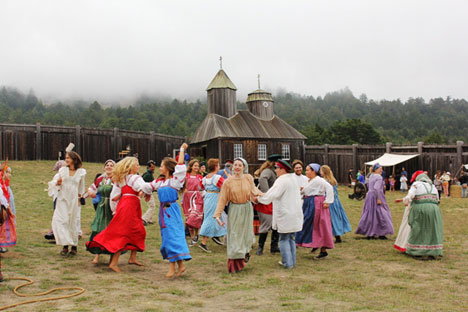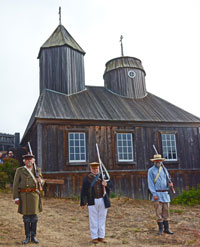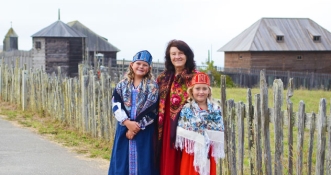Russians, Americans celebrate shared history in California

Source: Elena Bobrova
During July 27-29, Fort Ross Historic State Park celebrated its 201st anniversary. Located 80 miles north of San Francisco, the fort was established in Spring 1812 by Ivan Kuskov, a lieutenant of the Russian-American Company, who founded a colony in the region together with 25 Russians and 80 Aleuts.
The point of the endeavor was produce much-needed food for Russian settlements in Alaska and to expand the sea otter trade. The settlement was given the name "Ross" most likely to highlight poetically its connection with imperial Russia (Rossia). Russians maintained the settlement until 1842, when an agreement with settlements in British Columbia to provide food for Alaska rendered Fort Ross unnecessary.
This year’s anniversary celebrations began July 27 with performances and interactive experiences for all ages. Fort Ross founder Kuskov was originally from the Vologda Region city of Totma, and a large delegation from this region took part in the festivities this year, bringing with them the Northern Rainbow youth dance troupe from Vologda. Descents of the Kashaya tribe, who lived in the area when Fort Ross was built, also took part in the celebration, presenting traditional dances and storytelling.
Local volunteers and Fort Ross conservancy members took part in costumed re-enactments, 19th century crafts and the firing of historic cannons. Children played traditional games and watched a blacksmith, a weaver and a carpenter practice their craft in traditional ways. More than 3,000 people visited the park during the weekend.
Sergey Kislyak, Ambassador of the Russian Federation to the United States, was one of those who took part in the events. “Every time I come here I’m so touched by the way Russian history is preserved here with such care, such respect to the people who came from a very remote country, who came with peace and lived in peace with Kashaya. I admire the American people who work here and are willing to pass all their knowledge for the next generations,” Kislyak said.
Said Sarah Sweedler, president and C.E.O. of the Fort Ross Conservancy: “It’s really a place which brings all nations together; it’s common ground for Americans and Russians where we can collaborate on one project.”
Added former U.S. Ambassador to Russia John Beyrle, “Fort Ross is a unique piece of our shared history.”
On July 29, the U.S.-Russia Fort Ross Dialogue took place in Santa Rosa, looking for ways to bring this history to bear on the future. The one-day conference brought together Fort Ross Conservancy members and volunteers, scientists, diplomats, think tanks, government officials and businesspeople. Participants were welcomed by video message from cosmonauts on board the International Space Station (ISS). Beyrle joked that the ISS was a Russian-American colony in space.
Source: Youtube
One of the main focuses of the conference was the work of the U.S.-Russia Bilateral Presidential commission, formed in July 2009 by U.S. President Barack Obama and then-Russian President Dmitry Medvedev, as a way to improve communication and cooperation between the governments of their two countries. Today the commission consists of 20 working groups in such diverse areas as space cooperation, agriculture, health, environment, education, culture, sports and media, energy and business development.
Fort Ross became a project of the commission in 2010, when the state of California announced it was planning to close the park due to lack of funding. Eventually, a Memorandum of Understanding was signed between Russian metals holding company Renova and the Office of the Governor of California was signed, allowing the Renova Foundation to assist in the restoration of the fort.
Ambassador Kislyak suggested that students could be involved in further exploration and excavation of the territory around Fort Ross, as youth exchanges are one of the most successful avenues of U.S.-Russian cooperation. Kislyak noted that so far, archeological excavations have only been conducted on the parts of the Fort Ross site where native Americans lived, while the Russian section remains untouched.
Martina Morgan, who is Kashaya and has worked at Fort Ross for a year suggested another idea involving young people. “I dream to see kids from Russia coming for the Environmental Living Program, where they can portray a person from the Fort era for several days. I see how children from California keep that history alive,” Morgan said.
Related:
Why Russia lost colonies in the U.S.
Remembering the 200-year-old friendship between Russia and the U.S.
A second major theme of the discussions was the expansion of cooperation between the U.S. and Russia in the Pacific. Speakers suggested that businesspeople in both countries should follow the example of the explorers of the Russian-American company, who saw the West Coast of the U.S. as their neighborhood.
Although Russia has announced plans to increase investment in the Far East, trade between the U.S. and Russia in the region totaled only $36 billion in 2012 – down from $40 billion in 2011. One pressing need discussed at the meeting was the establishment of direct flights between the Russian Far East and the U.S. West Coast. Currently, travelers have to go through Moscow or Tokyo, increasing both time spent and cost.
Said Ambassador Beyrle, “Negative aspects just predominate in the Russia-U.S. relationship. We need them not to be characterized by ups and downs in political situation, which is always connected with names, such as Jackson-Vanik, Magnitsky, Snowden, Yakovlev. We need relationships based on the steady growth of our economics.”
All rights reserved by Rossiyskaya Gazeta.
Subscribe
to our newsletter!
Get the week's best stories straight to your inbox

